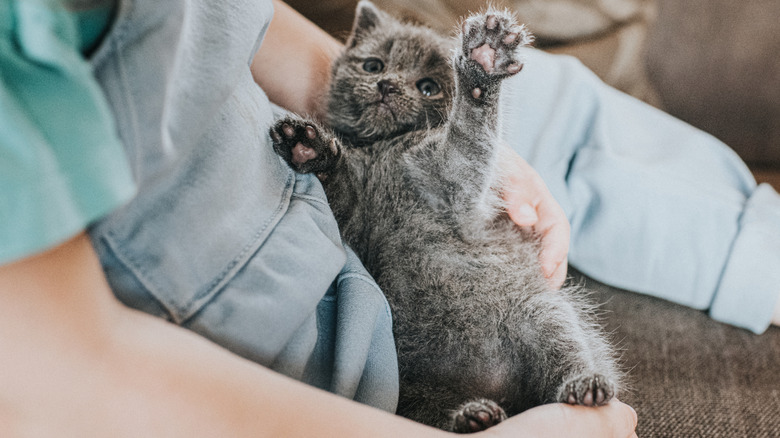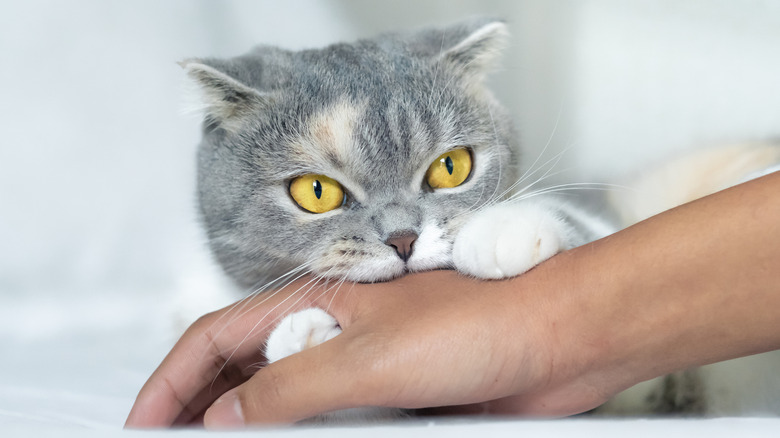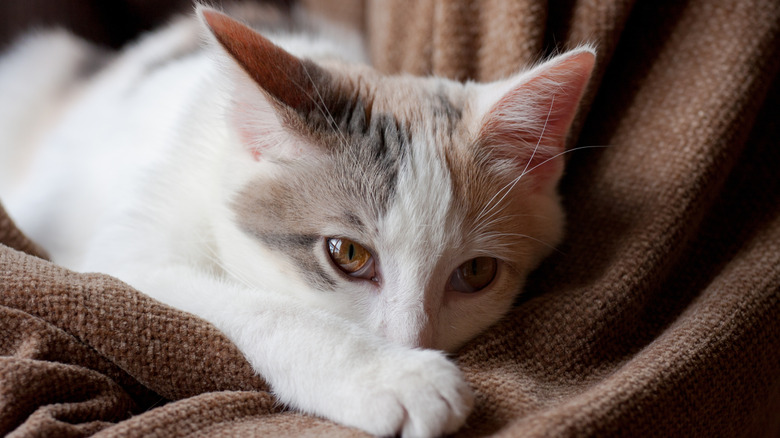Yes, Cat Scratch Fever Is A Real Thing (Here Are The Signs)
While "cat scratch fever" may sound like some sort of made-up illness, it's actually a very real thing. Thankfully, it's uncommon, though not impossible, for humans to contract the condition. Children 14 and younger are most at risk.
Cat scratch fever is derived from a bacteria called Bartonella henselae, which is pretty common in cats, especially those with fleas. When an infected cat scratches or bites a human, it can spread the disease; humans can also get it from being licked when cat saliva makes contact with open wounds or their eyes, mouth, or nose. It will usually resolve itself on its own, but antibiotics may be needed in more severe cases. Stray cats are more likely to be infected with the Bartonella bacteria than indoor cats. While fleas are the most common way cats get infected, they can also contract it if they get in a fight with a cat that is already infected.
Humans who get cat scratch fever generally show some mild symptoms. Cats with the condition, on the other hand, often don't show any signs of being infected, so it's best to use caution around cats to prevent being scratched or bitten. If you or someone you know has been bitten, scratched or licked by a cat and experiences any of these symptoms, there's a chance it could be cat scratch fever.
Redness and swelling at the site of infection
One of the first signs of cat scratch fever is going to be redness and swelling at the infection site. If a cat bites or scratches you and it seems like the wound isn't healing or just keeps getting worse, it could be a sign of cat scratch fever. Along with redness and swelling, you might also experience blistering where you were scratched, sometimes accompanied by pus.
Along with the symptoms that can occur at the actual site of the wound, a person with cat scratch fever may experience bumps under their skin that appear similar to a rash. These bumps will usually show up close to the spot where you were infected. And even after your scratch or bite heals, you can still experience other symptoms of cat scratch fever — these are just some of the first signs.
Swollen lymph nodes
Swollen lymph nodes are another common symptom of cat scratch fever — typically the nodes closest to the spot where you were bitten, scratched or licked will be the ones to swell. If you have the disease, your lymph nodes will swell one to three weeks after being infected, according to the CDC. If this happens, your doctor may have you undergo a lymph node biopsy to determine if the swelling is caused by cat scratch fever or a different condition.
Usually, lymph node swelling from cat scratch fever will go down on its own. Sometimes, though, swollen lymph nodes may cause pain. If this happens, applying a warm compress can help. In certain instances, swollen lymph nodes from cat scratch fever may start to drain. If you're worried about your or your child's swollen lymph nodes from possible cat scratch fever, talk to a doctor to see if treatment is necessary.
Flu-like symptoms
If you are dealing with cat scratch fever, you may experience flu-like symptoms. As the name suggests, a low-grade fever is a common sign of cat scratch fever. Typically, a fever due to this disease won't get higher than around 100.4 degrees, per Healthline. Headache and fatigue are two of the other common symptoms of cat scratch fever. Other potential flu-like signs include body, joint, and muscle aches. Someone with cat scratch fever may also experience a lack of appetite.
While these flu-like symptoms will usually clear up on their own, sometimes severe cat scratch fever that is left untreated can cause more dangerous symptoms. If a severe infection is left untreated, it's possible for it to spread to the organs and cause heart, brain, liver, and eye problems. If your fever isn't going away and your symptoms or infection site seem to be getting worse, it's best to see a doctor.
Preventing cat scratch fever
To protect yourself and your family from cat scratch fever, you are going to want to prevent your cat from contracting it in the first place. Since fleas are a common culprit of cat scratch fever, make sure to use flea protection on your cats. You should also keep your cat indoors and away from outdoor cats that could potentially pass on the disease.
Along with using flea protection and keeping your cat inside, you should also trim their claws regularly to prevent major damage from being done if they ever scratch. If your cat does scratch you, make sure to clean the wound as soon as possible. Teach any younger family members in your house how to play with cats in a respectful manner, as this will keep them safe and will make it less likely that your cat will scratch or bite during play.
Potential signs of cat scratch fever in cats
Most cats are not going to show any sign of having cat scratch fever. However, there are some signs to look out for that may show up in some cats. These symptoms are rare, though, and you most likely won't be able to tell if your cat is infected just by looking at them or the way they act.
If a cat shows any symptoms of cat scratch fever, they may have some signs that are similar to those of humans, such as swollen lymph nodes and a loss of appetite where your cat may stop eating. In some cases, they may deal with a heart infection or a transient fever. Most cats with cat scratch fever do not need treatment and are able to recover on their own. In rare circumstances, antibiotics might be needed for a cat that is showing symptoms.





